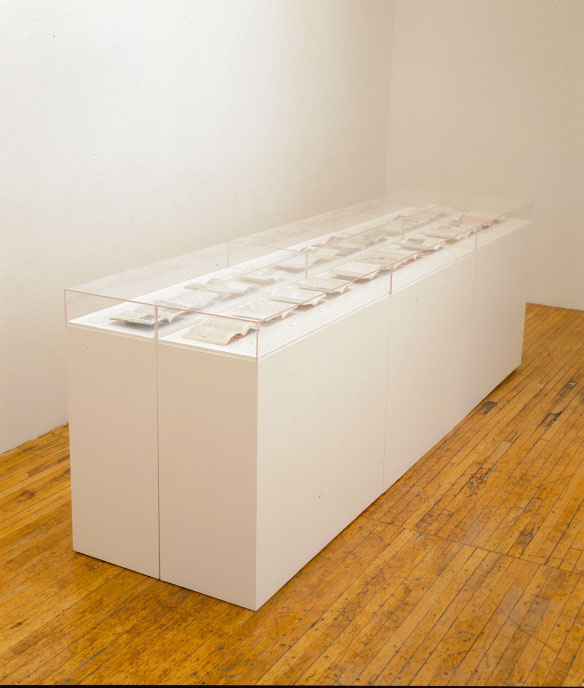Interpellations
16 April – 7 May 1994
American Fine Arts, Co., New York
Exhibition Space:
Six display cases, chipboard, painted; Plexiglas, bookracks, each 46 x 48 x 18 inches; total dimensions: 46 x 144 x 36 inches
– Vitrine 1, 1994, four English-language travel guides, manipulated; Private collection, New York
– Vitrines 2, 3, 1994, four English-language travel guides each, manipulated
– Vitrines 4, 5, 6, 1994, four German-language travel guides each, manipulated
Office of the Gallery Owner:
– Table vitrine, 1994, two English-language travel guides, manipulated; chipboard, painted; Plexiglas, bookracks; 18 x 26 x 6 inches; Themistocles and Dare Michos, San Francisco
In “Interpellations,” Müller designed six vitrines for the display of New York City travel guides in which the gallery American Fine Arts, Co., was not listed. Three of the vitrines contained English-language publications; across from them stood the other three with German publications. The monumentality of the large white showcases gave an air of preciousness to the open books and magazines within, meticulously mounted and labeled in museum-like fashion. As in Müller’s other exhibitions at American Fine Arts, only individual parts of the show were for sale, not the entire installation. In each of the travel guides, American Fine Arts was incorporated as an “interpellation.” The corrections were laid out on white photographic paper by means of transparencies, with design details, typography, writing style, and type of photographs reproduced as closely as possible. For example, a photograph of Leo Castelli at one of his exhibitions was replaced by a photograph of Colin de Land at Müller’s installation “A Sense of Friendliness, Mellowness, and Permanence.” In other instances, street directions to famous New York exhibition spaces were “corrected” to guide the reader to American Fine Arts. Along with the vitrines, James Meyer’s article, “The Condition of Bohemia,” was also exhibited. Stapled to the wall of the gallery, the text placed the author’s previously curated exhibitions at American Fine Arts in relation to “Interpellations.”
After its move to Wooster Street at the far end of Soho in 1994, American Fine Arts was listed in Artforum at first only in its own advertisement. For months, the exterior façade of the building bore no sign. Despite the traditional-sounding name, the program of the gallery was neither specifically “American” nor obligated to the classical notion of “Fine Arts.” American Fine Arts was a commercial space that did not immediately disclose itself to potential clients on either the outside or the inside. Colin de Land’s primary focus was on conceptual artists. Müller’s “Interpellations” made visible the self-marginalization resulting from this position on the periphery of both the commercial and the popular. His treatment of the gallery space and its forms of representation resonated with the “no longer fine arts” idea, the gallery’s conceptual emphasis, and therewith its own invisibility on the market.
Essay by James Meyer available here.


